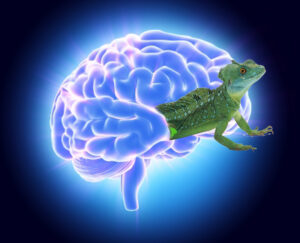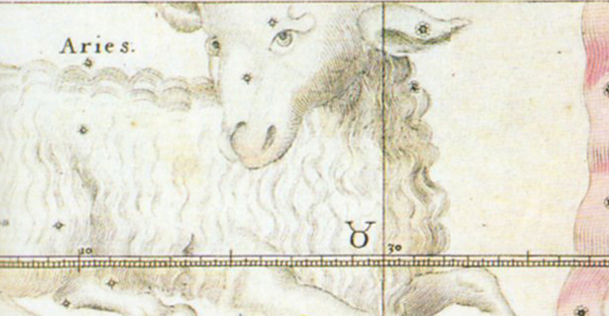It’s not your lizard brain – it’s the culture
I’m sick of hearing about the lizard brain.
You know the drill: the seat of our fear. Blah blah. It’s like the ‘sabre tooth tiger’ meme – if I hear yet another personal-development coach talking about how we’re programmed for ‘flight or fight’ because we had to run away from sabre tooth tigers… please spare me your tired metaphors.
The lizard brain is a myth. I don’t mean ‘myth’ in the disparaging sense of a ‘lie’ or ‘delusion’, I mean it in the sense that it is a symbolic story for a cultural paradigm.
Even people whose ideas I respect still fall into the use of this old cliché, without questioning it.
“Your lizard brain is hungry, scared, angry and horny… the lizard brain only wants to eat and be safe… the lizard brain will fight (to the death) if it has to but would rather run away. …the lizard brain cares what everyone else thinks, because status in the tribe is essential to its survival. …Wild animals are wild because the only brain they possess is a lizard brain. The lizard brain is not merely a concept. It’s real, and it’s living on the top of your spine, fighting for your survival. But, of course, survival and success are not the same thing… the lizard brain is the reason you’re afraid… The lizard brain is the source of the resistance.”
Says the otherwise very smart Seth Godin in Linchpin. Not only does he conflate some biological impossibilities in his metaphors (lizards are not tribal, for example), he has fallen prey to the cliché (nice image isn’t it, clichés skulking about looking for people to prey upon?).
In fact, the ‘lizard brain’ is a misnomer, and lumping the amygdala with the lizard brain is a total furphy.
Not only is the amygdala not a lizard brain, the idea that the primitive reptilian brain is nested inside our larger human brain may make for colourful metaphors but it’s also inaccurate.
Scientists come up with theories and these work their way into popular culture where they continue to be presented as a scientific fact even when the original theory has evolved.
“One reason that the triune-brain model has so captured people’s imaginations is that it is so simple and meshes so perfectly with a very old conception of the three basic elements of human nature: will, emotion, and rationality (or, more colorfully, ‘gut, heart, and head’). This model thus posits three brains that emerged in succession in the course of evolution and are now nested one inside the other in the modern human brain: a “reptilian brain” in charge of survival functions, a “limbic brain” in charge of emotions, and the neocortex, in charge of abstract, rational thinking.” (Source)
Ideas about brain modelling have changed and the triune brain is considered out of date. It’s now recognised that reptiles and mammals diverged at some evolutionary point and reptiles developed their own cortex, so they simply have a different brain altogether.
Why does it matter? Am I just being pedantic?
Certainly, myths do not have to follow scientific facts, and even if the original brain model was shaped by cultural notions of human nature isn’t the lizard brain analogy simply making a point that we need to confront our natural tendency to fear in order to live our full life potential? Thus, it’s about the effectiveness of the personal or business coach’s process rather than whether his or her metaphor is actually scientific?
Well, yes, the results are what’s important. However, if you are going to frame method within brain science at least check the science.
But there is a bigger story here that we must challenge: are we really biologically wired for fear?
What if, instead of offering evolutionary leaps, that personal development metaphor is locking people into an old paradigm; adapting them to fit a dysfunctional world view rather than assisting them to transcend it?
So, bear with me as I dismantle this cultural myth of our “hungry, scared, angry” lizard brain, this biological tendency in our animal nature, which we must overcome to be successful humans.

What is the impact of this idea that we, like all other animals, are ‘wired’ for fear and that we must overcome this biological instinct in order to become more successful humans?
There is a direct line from ‘overcoming’ our animal nature to the notion that one must strive to be superior not only to animals but also to other humans.
This idea has been around as long as the concept of ‘civilisation’, and overcoming stuff is entwined with the very human need to be in control.
Our intention to master whatever gets in between us and our ambitions (or threatens our sense of safety) has produced our extraordinary knowledge systems and our technologies. And yet, faith in our superiority and our divine right to exploit any and all resources has long been used to justify the oppression of ‘other’ people (ethnic cleansing, slavery), to create systems that ultimately destroy environments (fossil fuels, pesticides), and to convince ourselves that we can master everything including the weather.
Back in 1852 Herbert Spencer coined the phrase ‘survival of the fittest’. Seven years later Darwin provided the theory that evolved ‘survival of the fittest’ into Social Darwinism, founded on the idea that the biologically superior members of the species will survive. How ‘superior’ is determined depends upon interpretation and cultural bias, but that’s another story. (We saw how effectively Hitler dealt with that one). The theory that evolution is a competition that determines who’s superior conveniently reinforced the accepted social paradigm of the 19th century. It also shaped scientific research, creating a feedback loop that confirmed the social theory!
Thus, progress and, by inference, superiority is all about overcoming that pesky lizard brain.
Fortunately, unless you live in Richard Dawkins’ universe, cultural thought has moved away from its obsession with competition as the basis for evolutionary ‘survival of fittest’. The late 20th century brought a shift in social attitudes and, due to the inevitable feedback loop between science and society, hypotheses about the value of cooperation began finding evidence that cooperation is equally as important for survival. (Could it be that half the story had never been told due to the inherent masculine bias of science? Something to explore another day.)
While nothing in science is ever concluded, at least the research is now taking us beyond the ‘fight or flight’ scenario of ‘survival of the fittest’.
One small but significant shift: researchers now consider the amygdala isn’t simply a threat detector ‘fighting for our survival’. Its function is much less emotionally charged than that:
“The amygdala appears initially to evaluate the relevance of stimuli, and then to tune the individual’s overall cognitive and emotional response.”
When it comes to the way we move through our environment it makes sense that ‘uncertainty is more arousing than what’s familiar’. However, some now argue that the amygdala is alerting us to anything that might be ‘important to furthering one’s goals and motivations’ and this depends on the psychological state of the individual.
The amygdala is not ‘the fear centre’. The amygdala is the part of the brain that sorts ‘different’ from common/ ordinary/ normal. In the face of difference there are more responses than fight or flight, otherwise the human race would never have exited Africa. Curiosity shapes the human as much as fear (and it’s the same for many animals).
If we can watch Attenborough’s plethora of wildlife documentaries without paying too much attention to the survivalist clichés – and making allowance for the artifice of filming documentaries – we can witness the behaviour of animals. Does a gazelle spend all its time examining the environment for lions? And how is it that you can see a combination of animals that would normally be the eaten hanging out around water holes with animals that would normally eat them? I’m not saying they’re socialising together, but I am saying their amygdala hasn’t got them running in the other direction.
Even animals cannot survive in a constant state of fear, for the simple reason that all those functions of the parasympathetic nervous system like digestion and reproduction would just not work, leading to demise of the species. Thus, if life on earth is dependent upon ‘fight or flight’ there’s unlikely to be any life.
Detection of difference is an innate animal instinct. This is the amygdala’s job.
Fear is a response to uncertainty, a recognition of difference, but it doesn’t have to be the only response.
And to what degree is fear primed by culture?
What if this cultural habit we have of always trying to be in control is flooding our amygdala with stress chemicals, sparking fear and suppressing our innate instincts for appropriate action in any given moment?
Because it gets more interesting when research reveals cultural nuance in what activates the amygdala.
While it’s well established that the amygdalas of depressed or anxious people are triggered by negative stimuli, a 2013 study considered whether happy people simply had a less active amygdala because they are less fearful. What researchers found surprised them: happier people showed amygdala response to positive stimuli, but while their amygdala tuned into the positive stimuli this “did not come at the cost of losing sensitivity to the negative”.
In other words, they weren’t happy because they could ignore unpleasant things, but instead their amygdala had a balanced response to both extremes.
The researchers propose that instead of focusing entirely on avoiding personal harm, the amygdala is involved in empathetic response as it’s also activated by seeing others in need.
This suggests that our amygdala is primed by our psychological state, and how can we separate our mental or emotional state from our cultural milieu?
Neuroscience labels a person’s capacity to regulate their emotional reactions as their ‘affective style’ and considers it a combination of nature and nurture. And if the role of the amygdala is simply to help us know what signals to pay attention to this makes it a neutral observer, that is then overlaid with cultural patterning.
This is not to say that babies are born as blank slates with neutral amygdalas. It’s much more complex than that with an unborn child already affected by layers of cultural practices, as well as environmental and social conditions, which humans may or may not be able to control.
Levels of anxiety can be ramped up by the in-utero experience, which is intimately linked to their mother’s environment, her psyche and her social situation. Even the grandparents’ experiences affect the baby’s gene expression through epigenetics. And recent microbiome research tells us that before we’re born our mother’s microbial world is already impacting our emotional or mental propensities, which are entwined in multiple ways, with these microbes through our gut-brain axis and neuro-biology, (amygdala included).
We also can’t discount medical-cultural practices that affect the microbiome, the chemical body burden of living in toxic environments, and the stress of trauma or unjust social systems.
Fear is not a biological imperative, it’s a cultural zeitgeist.
Fear is a secondary response, not an automatic primal response to a changing environment.
The amygdala looks for the unfamiliar in the environment, and it’s believed that it then checks in with memory to determine action. The response is mediated by the neurotransmitters already circulating through our system, and thus can’t be divorced from our general state of mind. As mentioned this could involve stress reactions from not feeling in control, canny assessments of opportunities, and compassionate consideration for the needs of others. And the activation involves more than visual cues, including information from other senses and underlying intuitive responses beyond our logical mind.
The amygdala is intricately connected into the larger awareness of brain, body and environment, and it’s responses are intimately related to our psychic-emotive state and our life experience .
Children raised in some indigenous Amazonian tribes self-learn not to put their fingers in the fire through a natural combination of curiosity and awareness. Such ‘laxness’ would be considered severe neglect in our society where we’re constantly protecting children from their own curiosity.
In his book The Healing Wisdom of Africa, Malidoma Somé makes this point:
“… the inability to perceive, the inability to understand, to indigenous people is symptomatic of an illness. If your psyche is disordered or deficient or overcharged, blocks are created in you that prevent comprehension and remembering…Another form of this illness is the inability to accept of even tolerate those who are different from us. Worse, this inability encourages suspicion, fear, and resentment. Thus, it is an illness of the collective psyche when different cultures don’t understand one another.”
Our history has many stories of what happened when Europeans encountered other cultures. These encounters between very different people didn’t always play out as conflict, but most of them did. From the conquistadors seeking gold in the Americas to slave labour for sugar, to grasslands for cattle, European ingenuity required the oppression of other cultures that were often times regarded with disdain and fear.
Looking back at this behaviour now, it’s hard not to see how the cultural, religious and commercial justifications of superiority reveal an illness in the collective psyche.
Economic systems that thrive on dominance and control of ‘resources’ create societies focused on competition – and a pervasive sense of not having enough (money, possessions, health, love). That certainly primes our amygdalas for fear!
“Uncertainty is more arousing than what’s familiar,” but the way our individual psyche deals with uncertainty is connected to our cultural training.
A healthy response to uncertainty involves dismantling a culture based on fear, and its deep roots in our psyche.
Thus, focusing on our own joyfulness and contentment may be a grassroots way to effect cultural change – in addition to all the other health benefits it offers.
As simplistic as this sounds, the most important clue offered by new insights into the amygdala: the more present we are in the moment, and the more we generally feel content with ourselves, the more likely our response to uncertainty and difference will be curiosity and openness instead of fear.
And the more likely our healthy instincts will lead us to the best response.
So, let’s see ‘fight or flight’ biological essentialism for what it is: survivalist propaganda that encourages a certain type of cultural zeitgeist – by which I mean it was an idea that captured the imaginations of cultural thought-leaders of the 19th and 20th century. It not only created the evolutionary biology paradigm, it shaped the story of progress.
And from there it captured the imagination of an already very fearful (unequal, unjust and warlike) society, and the rest is history. Leading all the way to where we are today.
It’s time to move on from this story.



